What Not to Put Down Your Garbage Disposal
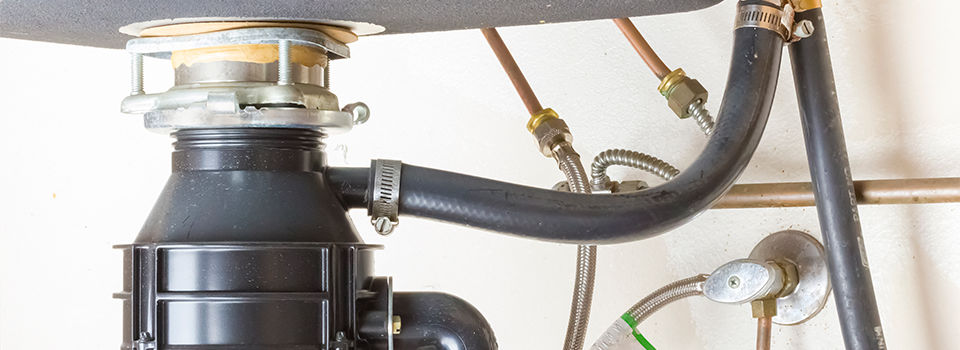
Have you ever put eggshells or coffee grounds in your garbage disposal? Don't feel bad, we’ve all been there. But did you know putting stuff like that in your disposal can actually damage it? We've put together this guide to help you easily brush up on what’s safe - and what isn't - to put down your sink. So whether have a new garbage disposal, are thinking of installing one, or just need a quick refresher, here are a few things to keep in mind:
Garbage disposals are electric-powered devices that are placed under a kitchen sink. They work by using either sharp blades or impellers to shred food into pieces that are small enough to safely pass through your plumbing system. As convenient as they are, these systems can be rather delicate and should be used with care. To ensure your garbage disposal lasts for years, check out these tips on proper care and maintenance.
The history of garbage disposals
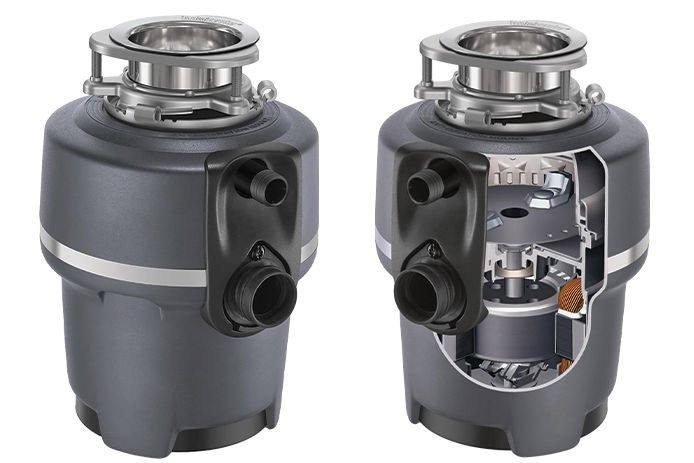
Before diving into the details of what’s safe to put in your garbage disposal, it may help to know a little bit about them. They have been around for quite some time. The first garbage disposal was invented in 1927 and sold by the company InSinkErator. Although they were used less in the 1930s and 40s due to city regulations on placing food waste in sewer systems, garbage disposal is now a common staple in houses all across the country.
Things you should never put down your garbage disposal

When taken care of properly, your garbage disposal should last for years. While it may be tempting to throw anything and everything down the disposal, there are some items you should avoid as they can actually cause damage. When placing food in your garbage disposal you should always avoid:
Bones: Bones and other hard foods like pits and seeds can damage your disposal's blades.
Coffee Grounds: One of the most common ways to damage your garbage disposal is by putting coffee grounds in it. They can easily build up and cause clogs. Instead, try disposing of used coffee grounds in your garden.
Grease: Different types of fats and grease tend to solidify when they cool. Avoid pouring these down your drain as they can harden and cause clogs in your system.
Egg shells: While many people believe egg shells are great for sharpening a garbage disposal’s blades, the egg membrane can actually get lodged around the blades and create a blockage.
Onions: Food like onions and their skin are similar to eggs. They have a membrane that can wrap around the blades and prevent them from working properly.
Potato skins: Since the skin of foods like potatoes are typically peeled super thin, they can actually slip through the blades without being chopped first. This can cause clogs to occur in your plumbing system.
Rice, pasta & oats: Foods like these expand as they get wet. Placing them down the garbage disposal can cause a sticky glue-like buildup in your sink.
What is okay to put down your garbage disposal?
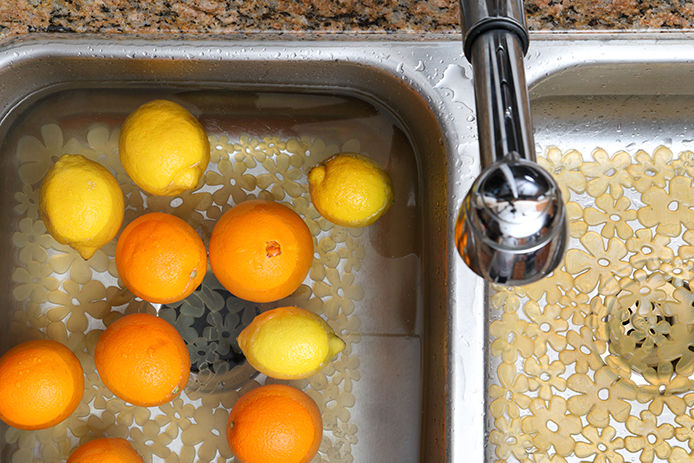
While some foods should be avoided, there are a lot of items that are perfectly safe to put down your garbage disposal, which can eliminate the amount of food waste in your trash can. Some items that are safe to put down your garbage disposal include:
Cold running water: You should always flush food down your disposal with cold running water to prevent waste from expanding as much as possible. This makes it easier to work its way through the sewer line and prevent clogs.
Ice cubes: Placing ice cubes in your disposal is a great way to help clean and sharpen the blades.
Lemons & oranges: Not only will these citrus fruits leave a clean, refreshing scent. But the acid in them will also help break down any debris that has built up.
Soft or liquid foods: Most soft and liquid foods can easily be placed in your garbage disposal. Likewise, many hard foods like fruits and vegetables are also safe.
Biodegradable soap: Most dishwashing detergents are great at cutting through any fat or grease that may have made its way into your garbage disposal.
How to fix a garbage disposal jam
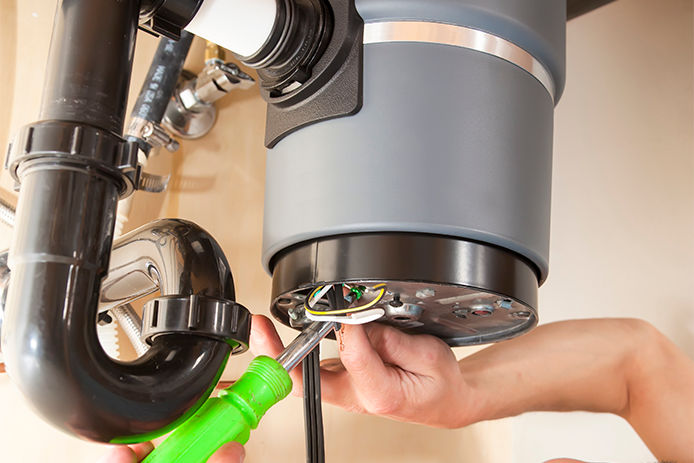
A jammed garbage disposal can be an extremely frustrating thing to deal with. Fortunately, there are a few things you can try before calling a professional.
Chances are your garbage disposal came with a key or wrench specifically designed to fix jams. If you don’t have one, a ¼-inch hex wrench should work for most garbage disposal brands. To unjam your garbage disposal, follow these steps:
- Turn off the power to your garbage disposal.
- Look at the bottom of your disposal and insert the key or wrench into the hole located near the center.
- Turn the key back and forth to clear anything that may be lodged between the flywheel and the housing.
If your garbage disposal does not have a key hole located near the bottom center, follow these steps to unjam it:
- Turn off the power to your garbage disposal.
- Insert a dowel rod or the end of a wooden spoon into the garbage disposal. Never insert your hand into a garbage disposal.
- Push the dowel road firmly against one of the impellers, pushing in a counterclockwise motion.
Once your jam has cleared, run cool water to rinse the debris down the drain, and power on the garbage disposal. If your disposal system is still jammed after trying these methods, it may be time to call a professional.
Garbage disposal safety
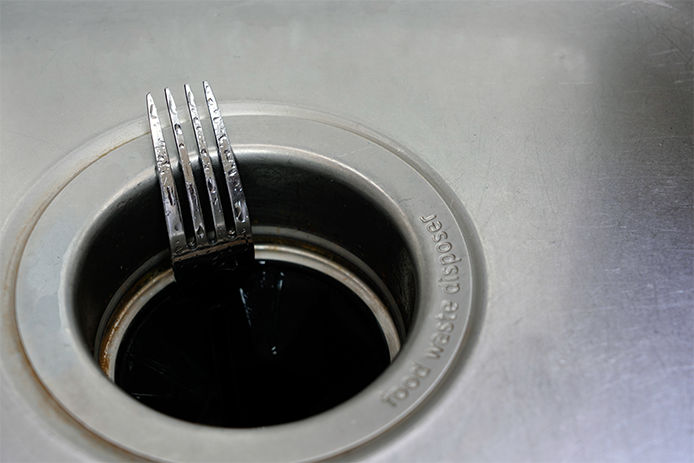
While garbage disposals can be extremely convenient, they can also be dangerous when used incorrectly. Follow these safety tips when using your garbage disposal to avoid injury:
- Never stick your hand down a garbage disposal drain.
- Never put glass, plastic, paper, or anything combustible down a garbage disposal.
- Avoid using bleach and other harsh chemicals in your garbage disposal.
- Be sure to run your garbage disposal with cold water at least every few days.
- Do not turn off the water or garbage disposal until everything has completely finished grinding.
- Keep rags and towels away from the sink when operating your garbage disposal.
- Never overfill your garbage disposal drain.
Now that you know the basics of garbage disposals, how they work, and what’s safe to put in them and what's not, you can start freeing space in the garbage for other things. Remember to always follow proper safety precautions when utilizing your garbage disposal, and if you are ever unsure about your garbage disposal system, it’s best to call a professional.